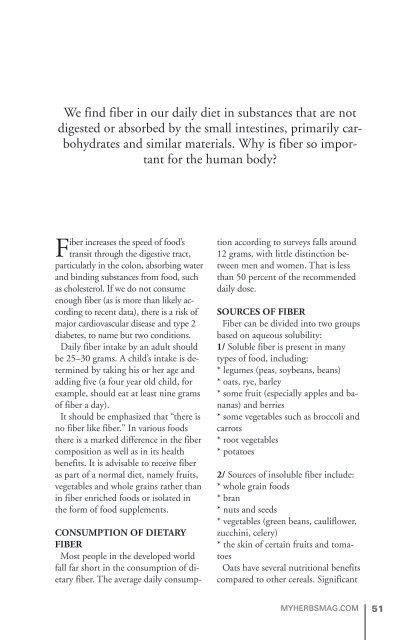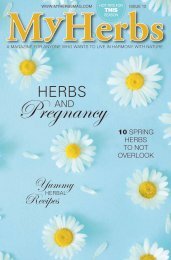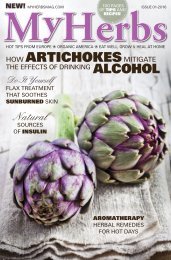My Herbs 1
Find out more on MYHERBS-STORE.COM. My Herbs is a special quarterly publication for anyone who is interested in alternative cooking, home grown herbs, and traditional or complementary medicine or healing methods, simply for everyone who wants to live in harmony with nature.
Find out more on MYHERBS-STORE.COM.
My Herbs is a special quarterly publication for anyone who is interested in alternative cooking, home grown herbs, and traditional or complementary medicine or healing methods, simply for everyone who wants to live in harmony with nature.
Create successful ePaper yourself
Turn your PDF publications into a flip-book with our unique Google optimized e-Paper software.
We find fiber in our daily diet in substances that are not<br />
digested or absorbed by the small intestines, primarily carbohydrates<br />
and similar materials. Why is fiber so important<br />
for the human body?<br />
Fiber increases the speed of food’s<br />
transit through the digestive tract,<br />
particularly in the colon, absorbing water<br />
and binding substances from food, such<br />
as cholesterol. If we do not consume<br />
enough fiber (as is more than likely according<br />
to recent data), there is a risk of<br />
major cardiovascular disease and type 2<br />
diabetes, to name but two conditions.<br />
Daily fiber intake by an adult should<br />
be 25–30 grams. A child’s intake is determined<br />
by taking his or her age and<br />
adding five (a four year old child, for<br />
example, should eat at least nine grams<br />
of fiber a day).<br />
It should be emphasized that “there is<br />
no fiber like fiber." In various foods<br />
there is a marked difference in the fiber<br />
composition as well as in its health<br />
benefits. It is advisable to receive fiber<br />
as part of a normal diet, namely fruits,<br />
vegetables and whole grains rather than<br />
in fiber enriched foods or isolated in<br />
the form of food supplements.<br />
CONSUMPTION OF DIETARY<br />
FIBER<br />
Most people in the developed world<br />
fall far short in the consumption of dietary<br />
fiber. The average daily consumption<br />
according to surveys falls around<br />
12 grams, with little distinction between<br />
men and women. That is less<br />
than 50 percent of the recommended<br />
daily dose.<br />
SOURCES OF FIBER<br />
Fiber can be divided into two groups<br />
based on aqueous solubility:<br />
1/ Soluble fiber is present in many<br />
types of food, including:<br />
* legumes (peas, soybeans, beans)<br />
* oats, rye, barley<br />
* some fruit (especially apples and bananas)<br />
and berries<br />
* some vegetables such as broccoli and<br />
carrots<br />
* root vegetables<br />
* potatoes<br />
2/ Sources of insoluble fiber include:<br />
* whole grain foods<br />
* bran<br />
* nuts and seeds<br />
* vegetables (green beans, cauliflower,<br />
zucchini, celery)<br />
* the skin of certain fruits and tomatoes<br />
Oats have several nutritional benefits<br />
compared to other cereals. Significant<br />
MYHERBSMAG.COM<br />
51












